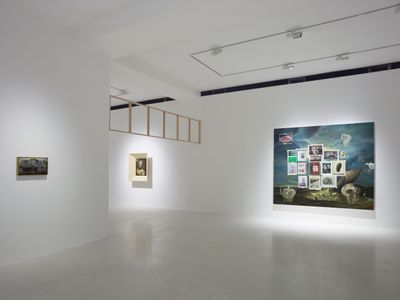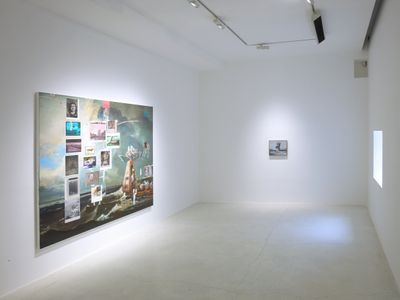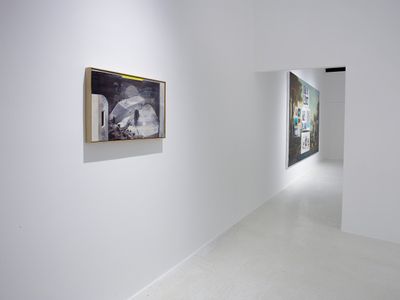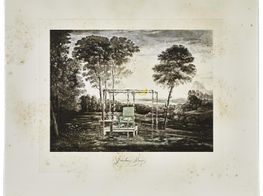Ged Quinn at Pearl Lam Galleries, Hong Kong
A former Liverpool rock musician with notable 1980s hits to his name, British artist Ged Quinn (b. 1963, UK) now comes off as an avid reader. Among the literary references in his current exhibition of paintings—Rose, Cherry, Iron Rust, Flamingo at Pearl Lam Gallery in Hong Kong (26 May–8 July 2017)—are magical realism, German art historian and cultural theorist Aby Warburg's Mnemosyne Atlas project (1924-9), the correspondences of Martin Heidegger and the abstracted poetic strategies of Ezra Pound. That is to say nothing of the plentiful quotations of Jean-Luc Godard's films and use of montage. Quinn's painting practice is defined by such citations of philosophy, literature, pop culture and cinema—all assembled on landscapes borrowed from history paintings by Baroque and Romantic masters such as Claude Lorrain and Nicolas Poussin. Discordant images make unexpected appearances in his scenes with Surrealist undertones, the apparent randomness of their combinations disrupting any linear narrative. Quinn intends the viewer's own memories and experiences to create intertextual readings of his paintings, bringing into question the power of iconography and metanarrative in images.
Ged Quinn. Courtesy the artist and Pearl Lam Galleries, Hong Kong/Shanghai/Singapore.
Quinn studied at Ruskin School of Art and also St Anne's College, Oxford; Slade School of Fine Art, London; Kunstakademie Düsseldorf and Rijksakademie van beeldende kunsten, Amsterdam. In 2003, he was the second artist chosen for the Tate St Ives Artists' Residency. Rose, Cherry, Iron Rust, Flamingo is Quinn's first solo exhibition in Asia. The title was inspired by the 'ideogrammic method' championed by Ezra Pound—a poetry technique that uses concrete images to illustrate abstract concepts. Ocula spoke with Quinn in Hong Kong on the occasion of the exhibition.
The exhibition text for the show suggests that when truth has been disenfranchised from its origins, the only way to provoke new meanings is to corrupt the source. This idea is rather apocalyptic—only after destruction can we be reborn. Both the corruption of truth and the desire to start anew seem to have current-day political parallels. Is your work political?
Very, but in a subtle way; that's one of the reasons I deal with montage. Previously, it's been slightly more surreal, it's had more magical realist narratives embedded in it. I think the references to posters, billboard, defacement and obliteration is quite a political thing. It's a type of breaking with history. One can't look into the distance or horizon, which would be beautiful, smoky, faded and inviting. In a way, the paintings deny that satisfaction and pleasure. So yes, they are political in that sense: the interruption of that idealised view.
You mentioned magical realism. Are you a reader of that type of literature?
Writers like Borges, yes. I used to read them for their ideas on things like plenitude narrative fiction—an encompassing range of subtly different concepts expressing a primarily realistic view of the real world while also adding or revealing magical concepts. I could see a parallel in ideas like the 'marvellous real' in literature and how much it could express of a complex and rich historical and cultural discourse. I think it was the Cuban writer Alejo Carpentier who defined the baroque by a lack of emptiness, a departure from structure or rules and an 'extraordinary' abundance (plenitude) of disorienting detail, and cited Mondrian as its opposite. Marvelous not meaning beautiful and pleasant, but extraordinary, strange and excellent.
Another big influence has been the Situationist International, a radical French Marxist group. They had an interesting method called détournement or misappropriation. They rerouted and hijacked expressions of capitalist media culture and turned it against itself in order to create something new. They were intensely political, using art to effect huge social changes often with a dark, anarchic humour. I looked at their work a lot.
Without a linear logic or method to the works, how do you select and arrange the imagery in them? Do you have a strategy?
I'm not aware of a conscious one. I think they work as a whole. I think you have things that interest you—say if you watch [Andrei] Tarkovsky films, you'll notice the thing he does with horses: there are always horses running or in the water; it's such a beautiful and evocative image. And it has a meaning beyond the surface. So I store things like this and think, 'Right, I can use this', and somehow form connections. [Gilles] Deleuze says meaning is not necessarily routed in one or another image—it can be elsewhere, between or in the way the images connect, so there isn't any hierarchy in the images. In a way, they kind of float freely, but you can read your own narratives through and across them. The meaning is in the totality.
After beginning work on this series, I discovered the Mnemosyne Atlas project by the German cultural historian Aby Warburg. I could see parallels between its concept and what I was working on, but knew that I was taking it further. Warburg's project was begun in 1924 and left unfinished at the time of his death in 1929. He was attempting to map the 'afterlife of antiquity': how images of great symbolic, intellectual and emotional power emerge in Western antiquity and then reappear and are reanimated in the art and cosmology of later times and places. His focus was on the Renaissance: the historical period where he found the struggle between the forces of reason and unreason to be most palpable. Warburg hoped his project would allow its spectators to experience for themselves the 'polarities' that riddle culture and thought.
I thought that his explorations in mapping thought would translate into pathways inside modern cinema, photography and the plethora of ancient and contemporary imagery. Warburg's placing of images followed his own metonymic, intuitive logic, even as it is propelled by decades of rigorous scholarship. He wanted these symbolic images—when juxtaposed and then placed in sequence—to foster immediate, synoptic insights into the afterlife of pathos-charged images depicting what he dubbed 'bewegtes Leben' (life in motion or animated life).
Given your background in music, can your work be interpreted as a form of 'remixing'?
Yes, interesting question. I hadn't made that connection consciously. It's sort of like sampling, but much more complex because there is so much more to draw on and reference.
In the paintings in the exhibition, the disparate imagery seems to be 'stuck on' to the landscape backgrounds with masking tape. In fact, this 'tape' is a painted trompe l'œil. Why did you decide to do this?
That's an interesting question too. It also begs the question of why paint the images at all, instead of just taping photos? I think it's important. I think pictorially my paintings became like a grid; they started to resemble a Mondrian-like structure. The images were supposed to be non-linear and discursive and random, but formally, they began to break up into rectangular areas. But in the end, they're still paintings. There's a struggle because I'm trying to not make a painting that has an internal logic so that one thinks, 'Oh my goodness, that's a really beautiful painting.' I see them more as documents to be read.
The works are quite jarring in a way, in that they repeatedly deny the viewer the satisfaction of understanding them. As soon as one thinks one has drawn a connection, one begins to doubt it.
That's right. It's intentional. News and information are very mediated through photography or the moving image. I'm curious about painting's ongoing relationship with photography because obviously when it was developed, it was presumed that would be the end of painting. But it didn't happen. In fact, it's sort of developed this strange, symbiotic relationship since then. Photography is influenced by painting as well. I think it's had a problematic relationship; we consciously draw on the photograph. I was interested in looking at that language too as I chose to paint.
While it is important to me that my interest and pleasure in the content and methods of my work is palpable, it is all done in the service of something more dispassionate and is generally about power structures and orthodoxies.
Were you trained in classical landscape painting in Oxford, London, Dusseldorf and Amsterdam?
No, I wasn't at all. I only looked at it as a spectator. I didn't study the techniques. In Amsterdam, I was doing film. All my techniques are self-taught. I consciously didn't want to learn techniques; in fact, it was important to me to not know how they were made. And I consciously didn't go and look at classical paintings; I thought then I would become slave to the originals and centuries of technique. I always work from reproductions. That's how most people consume images: through colour plates in magazines and books. That's what I did. I didn't want to go and see the patina and the age; I thought focusing on those methods could lead me down a blind alley. They served their age. These works respond to now.
Do you avoid museums?
I don't anymore, but I did when I started. I feel that I have enough now that I know precisely what I'm doing—that I can go look in museums and it's okay. I thought it would be really a problematic thing to do. I think they set boundaries. I never intended my practice to be about fine painting; it was really only a vehicle. It only had to be good enough, it didn't have to be technically brilliant. It just had to be good enough to carry the ideas I wanted it to. So this work alludes to history, but isn't reactionary.
In a previous interview, you said that you didn't fall for the gallery atmosphere in the UK post-Damien Hirst's warehouse show, and in fact said that you 'needed to get out and discover what I wanted to do rather than tap into that consciousness that was flying around.' How did you do that?
I moved a long way from London. There was always a constant sense of positioning in the London art world at the time. It was tempting to go to one of these young galleries, see a show and think, 'How am I in relation to that work?' It was a matter of reacting to something you'd seen that would slightly alter your compass. It was a very virile time and there was a lot of excitement. Everybody was aware that if you got it 'right', you could make a lot of money and become an art 'superstar' very quickly. It wasn't healthy; I don't think it was the best condition to evolve your own thinking. So, I just got right away from it and started to think about what I wanted to do in total isolation.
The title of the show—Rose, Cherry, Iron Rust, Flamingo—is borrowed from Ezra Pound's ideogrammic method, which allowed poetry to deal with abstract content through combined concrete images. The title almost paints a more accurate picture of the colour red than the word 'red' ever could.
I think that feeds into painting. I think it's very beautiful and delicate. You're absolutely right that it paints a better picture of red than just the simple word 'red'.
It's interesting that Ezra Pound's ideas about the ideogrammic method were inspired by Chinese characters.
This is coincidental, because I'd been a fan of Pound for a long time. It wasn't titled that way because the show is in Hong Kong at all. A lot of the work deals with exemplary practitioners of high Modernism like Mondrian and Malevich. When I was being educated, Modernism—truth to form and truth to material—was the thing to aim for. And then this new wave of painting came out of Germany that rejected Modernism totally. It was a very strange time and a strange adjustment. It was quite chaotic and I think it liberated a lot of this straight-laced authoritarianism. One realised that Modernism, although it was sublimely beautiful with its clarity and ideals, was an orthodoxy that actually had very strict rules. Being an artist is about freedom.
Ezra Pound illustrates his ideogrammic method by explaining the way the Chinese characters are formed, giving the example of the character for 'east'. Essentially, it is a superposition of the characters for 'tree' and 'sun'; the sun tangled in a tree's branches suggests the sunrise. Isn't it gorgeous?
It is. How did you choose the film stills that you've used?
Partly through the subtitles that were on them at the time, which for me read like a kind of layer of poetry. Partly because I just respond to them. It's a sort of freedom, it's like an intellectual nomadism. You're just wandering and you relate to something or you don't. You stop to look. You collect. You build your own museum of images. When you make a collage or a montage, you can use the same image and alter its meaning by putting it in one place rather than another, putting it next to another image rather than the next.
You've said that the space between the images in your paintings are important because one's perception is altered by juxtaposition. What do you mean by this?
Again, because there's no hierarchy. One image isn't necessarily more important than another. Its more how they relate to one another. So, again I go back to that thing that Deleuze wrote about the frontier belonging to both. The iconography exists in the relationships between the images, rather than the iconography of the images themselves. The viewer's memory and understanding of the illusion and collision—this play of where privilege, value and meaning can occur—is, for me, reminiscent of the work of an author like [WG] Sebald, where image and memory both advise and deny our understanding of the lived experience. He said that photographs are emanations of the dead. If you see a photograph or someone shows you something and then it takes you somewhere, everything changes. And the idea that the truth or understanding of a scene may be located somewhere other than in the image itself—in what you bring to it, in between, on the frontier. —[O]














































































































































































